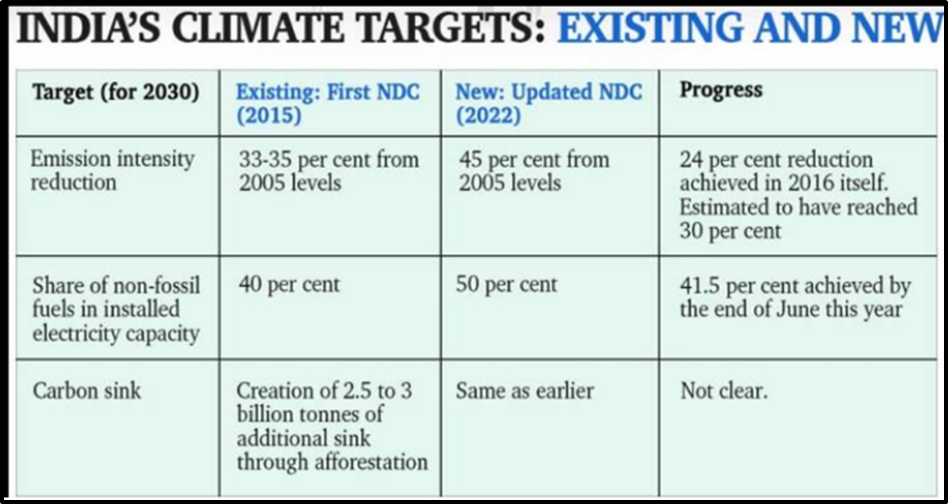Context-
As the new government in India settles into its role, the actions it takes to enhance climate initiatives will impact every ministry and sector. These choices will be crucial in determining India's sustainable economic trajectory, positioning the nation as a leading voice of the Global South, and advocating for climate finance and justice over the next five years.
India's Climate Transformation
Over the past decade, India has shown remarkable progress and intent in addressing climate change. It has evolved from a hesitant participant in global climate discussions to a proactive leader shaping global narratives and institutions. This transformation is evident through several key initiatives:
- Foundation of Global Institutions: India has been instrumental in establishing significant global institutions such as the International Solar Alliance, the Coalition for Disaster Resilient Infrastructure, and the Global Biofuels Alliance. Additionally, it played a crucial role in shaping the Green Development Pact under its G-20 presidency last year.
- Ambitious Emission Mitigation Targets: For the first time, India is discussing bolder emission mitigation targets. The announcement of the 2070 net-zero target and ambitious Nationally Determined Contributions (NDCs) are significant milestones. By committing to the net-zero goal, India has acknowledged the importance of absolute emission reductions over relative emissions-intensity-based targets. This shift has sparked domestic debate among policymakers, the private sector, and various other actors.
- Sustainability-Linked Economic Policies: Sustainability is no longer on the margins of economic policy. The creation of an Indian emissions carbon trading scheme, which is expected to operate for at least 30-40 years, exemplifies this shift.

Accelerating Climate Action
In the next five years, the government must accelerate its efforts to demonstrate that economic development can be sustainable. India should adopt the mantra of "go higher, go wider, go deeper" to align its climate leadership with its economic ambitions.
Go Higher: Enhancing Global Leadership
To solidify its position as a global climate leader, India could aim to host significant international climate summits. For instance, if India were to host the United Nations Conference of Parties (COP) in 2028, it would need to ensure its success matches that of its G-20 Presidency. Given the timeline of global negotiations, four years is a relatively short period. Key questions to address include:
- Should India push for a global agreement to halt new investments in oil and gas after 2030?
- Should it advocate for substantial commitments on adaptation finance to help developing countries cope with increasing heatwaves, storms, floods, and droughts?
Reaching a consensus on these contentious issues typically takes four to five years. Therefore, India must begin its efforts immediately, identifying potential big wins for 2028 and building alliances to support these goals. Simultaneously, India should continue promoting the narrative of equity in international forums and carve out a leadership role in global institutions focused on climate finance.
Go Wider: Expanding Sectoral Emission Targets
India has made significant strides in the power sector and must continue this progress to meet its international non-fossil fuel targets and domestic renewable energy goals. However, it is now time to broaden these targets to other sectors. This expansion could include:
- Setting clear targets for zero-carbon two- and four-wheelers, particularly in the private mobility space. This initiative would not only benefit urban areas but also help rural India become more mobile, create jobs in clean energy and sustainability, and drive economic growth.
Credible policy goals have proven to be powerful signals that compel industries and stakeholders to act. The NDC for 2035, due to be submitted next year, presents an opportunity to expand India’s energy transition targets across various sectors.
State-Level Climate Action
Go Deeper: Enhancing Sub-National Climate Action
Sub-national climate action and resilience must be prioritized during this term of the government. While some progress is already visible, more needs to be done. The Council on Energy, Environment, and Water (CEEW) is working with several Indian states to support their net-zero plans through long-term climate and energy modeling. For example, CEEW has collaborated with Tamil Nadu and Bihar on their plans for transitioning to a net-zero future.
To further this agenda, the government should consider:
- Creating a Centre-State coordination group to incentivize state-level climate actions through the Sixteenth Finance Commission.
- Promoting deeper integration of scientific modeling capabilities in policymaking.
- Facilitating a unified data measurement, reporting, and verification (MRV) architecture at the state level.
Given India’s federal structure, these recommendations do not imply centralizing climate actions but rather ensuring better coordination of state-level actions while maintaining their autonomy. This approach requires moving beyond states individually addressing the climate crisis and having the Centre actively facilitate and support their efforts.
Conclusion
The new government must elevate India’s global climate leadership in its new term, focusing on a strategic, long-term approach spanning at least the next four to five years. India’s participation in global climate discussions has evolved significantly, and it now holds a seat at most international tables. The task ahead is to demonstrate its prowess and lead by example.
The proposed "higher, wider, deeper" strategy will be instrumental in achieving this goal. By enhancing global leadership, expanding sectoral emission targets, and promoting coordinated sub-national actions, India can set a precedent for sustainable economic development and assert its position as a global climate leader.
|
Probable questions for UPSC Mains Exam-
|
Source- The Hindu







